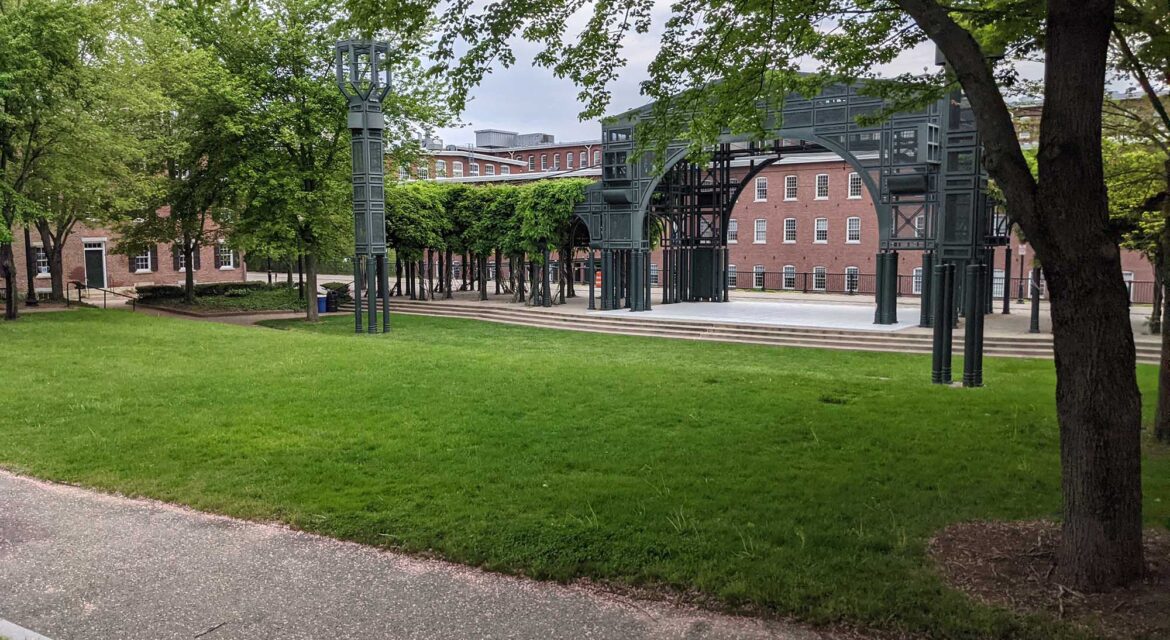 The factories and boardinghouses of Lowell, Massachusetts, helped to define the early history of the city and the Industrial Revolution as a whole in the region. Many of these structures were lost over the decades, but one of the boardinghouse complexes that was saved enabled the creation of Boarding House Park. This greenspace has become a hub of community activity in a way that both preserves and celebrates an essential element of Lowell history.
The factories and boardinghouses of Lowell, Massachusetts, helped to define the early history of the city and the Industrial Revolution as a whole in the region. Many of these structures were lost over the decades, but one of the boardinghouse complexes that was saved enabled the creation of Boarding House Park. This greenspace has become a hub of community activity in a way that both preserves and celebrates an essential element of Lowell history.

Preserving and Representing Factory Cities
 The boardinghouse block that defines Boarding House Park was built in 1837. Textile corporations built dozens of these boardinghouses to serve the basic needs of their workforce, which were mostly young single women. Known as “mill girls,” these young women hailed largely from New England’s rural villages and farms.
The boardinghouse block that defines Boarding House Park was built in 1837. Textile corporations built dozens of these boardinghouses to serve the basic needs of their workforce, which were mostly young single women. Known as “mill girls,” these young women hailed largely from New England’s rural villages and farms.
Changes with social values and the market would bring an end to the boardinghouse lifestyle. The buildings were sold off, converted to storage facilities or demolished to make way for other structures. Neglect and urban renewal resulted in the loss of almost all of Lowell’s boardinghouses. Efforts to save this history led to the creation of the Preservation District and the Lowell National Historical Park, which is managed by the National Park Service.
These efforts would enable the creation of Boarding House Park as well as displays like the Mill Girls & Immigrants Exhibits. The exhibit is housed in the Patrick J. Mogan Cultural Center in a reconstructed corporation boardinghouse that sits next to Boarding House Park, where visitors can explore this history but can also experience many of the elements that define the modern community.

The Lowell Sculptures, Summer Music Series and More
 Boarding House Park has numerous features that make it distinct but are also connected to the history and culture of the city. The Lowell Sculptures, located in the three corners of the park, are composed of simple forms based on Lowell symbols that have been combined in a modular design The shapes represent aspects of factory cities. Sculpture One includes a silhouette of Francis Cabot Lowell, for whom the city was named.
Boarding House Park has numerous features that make it distinct but are also connected to the history and culture of the city. The Lowell Sculptures, located in the three corners of the park, are composed of simple forms based on Lowell symbols that have been combined in a modular design The shapes represent aspects of factory cities. Sculpture One includes a silhouette of Francis Cabot Lowell, for whom the city was named.
For over 30 years, the Lowell Summer Music Series has taken place in Boarding House Park. This outdoor concert has featured some of the biggest names in music, attracting audiences from across the region. With a general admission capacity of 2,000 the concert has been able to cultivate attention and interest from both residents and visitors.
Boarding House Park provides audiences with an ideal starting place to further explore the history contained in Lowell National Historic Park and the rest of the Preservation District, but they can just as easily take in the natural and urban surroundings that have been combined in the space. This variety has defined a legacy that connects Boarding House Park to the past and future of Lowell.
How History Can Define a Community
 Many of the boardinghouses that defined the early days of Lowell have been destroyed or displayed. The creation of Lowell National Historic Park has preserved this history, while Boarding House Park specifically showcases how such efforts can cultivate activity across an entire community to everyone’s benefit.
Many of the boardinghouses that defined the early days of Lowell have been destroyed or displayed. The creation of Lowell National Historic Park has preserved this history, while Boarding House Park specifically showcases how such efforts can cultivate activity across an entire community to everyone’s benefit.


